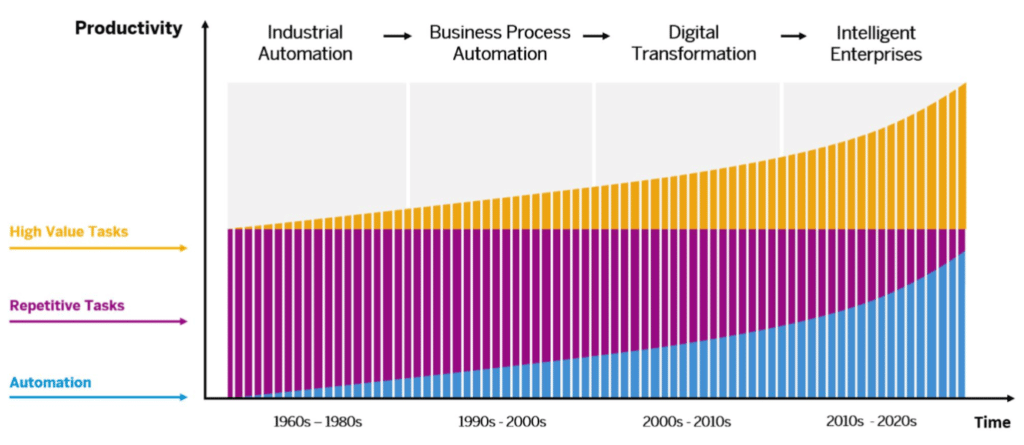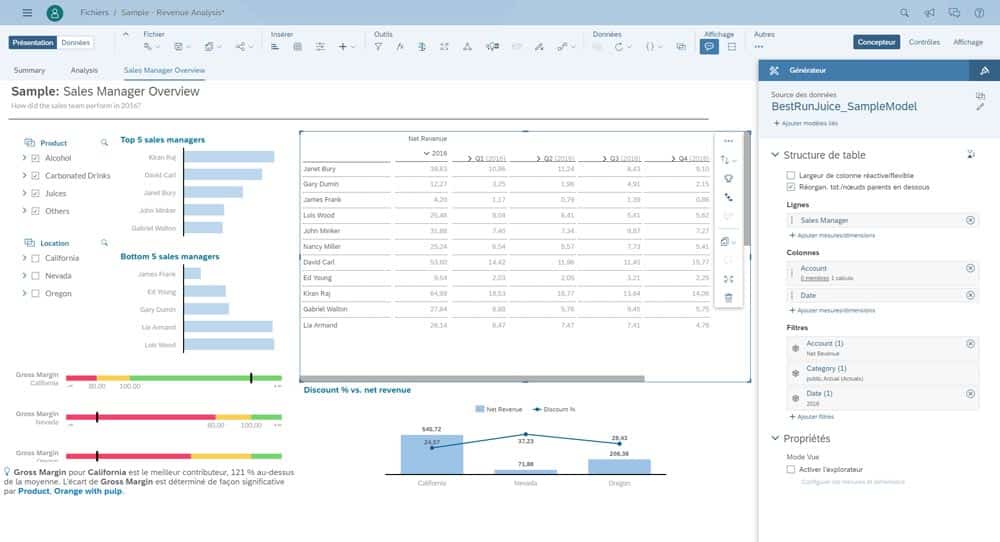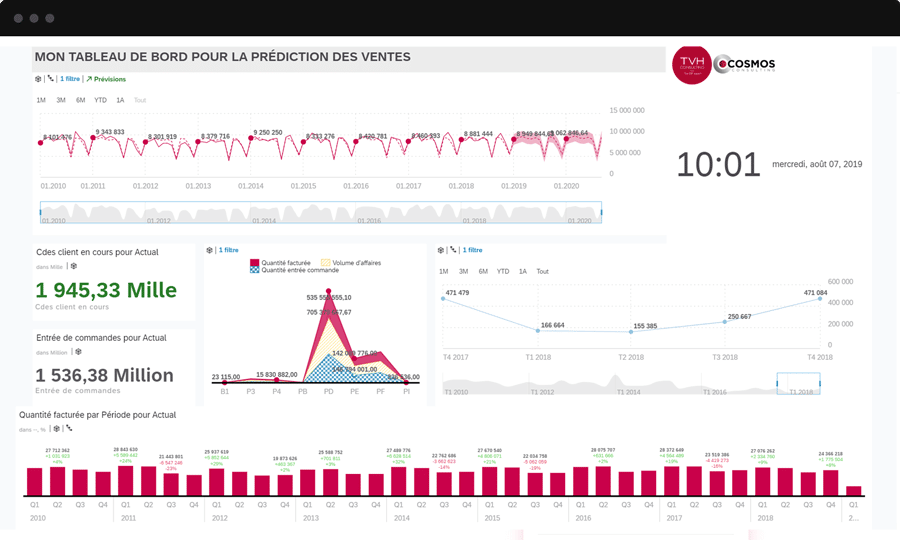On the cusp of a significant technological turning point, and with the words “digital transformation” on everyone’s lips, is there an ideal road map for your Business Intelligence project? While BI is still the poor relation of major IT projects such as ERP migration, it nevertheless remains one of the most potent drivers of performance improvements for businesses.
SAP summarizes its value perfectly in the diagram below, reiterating that revolutions and evolutions are exponential and accelerate over time. Once a business has automated its processes and digitalized its operations, the final step is to strive for excellence through being a smarter business where permanent decision support is available to help its people focus on higher value-added tasks that are sources of productivity and growth.

This diagram also shows us that digital transformation and business intelligence go hand-in-hand, as the value created by digital is maximized by BI. This is why new solutions are emerging that offer practical solutions to meet the tough and immediate challenges surrounding modernizing the management of businesses. There may not be a magic wand exactly, but leveraging the value of data contained in ERP systems has never been easier; the technological hurdles have been overcome and businesses can now concentrate on exploiting data for the benefit of collective intelligence.
The keys to successful transformation
The digital transformation of organizations, desired by both senior management and end users alike, has become a necessity. In under 10 years, users’ relationship with IT has changed. Previously, the way they used IT in the workplace was their benchmark in terms of design and features. These days, the reverse applies, and the digitalization of their personal lives and private affairs has set new standards, making their user experience with business systems poor by comparison. The simple and intuitive solutions offered by the likes of Google, Amazon and Dropbox, to name just a few, inevitably change users’ expectations from business information systems.
Yesterday’s best practices are therefore nothing more than today’s normal, and this reiterates the key success factor behind any IT project – boosting user buy-in and responding fully to business needs.
Converging digital transformation with business intelligence practices therefore does not mean rushing headlong into implementing dozens of cloud-based or SaaS tools, which would result in additional spending, a substantial workload and a not insignificant risk of failure. It is preferable to start by asking the right questions. Then you will better understand how to respond to business management issues and assess whether current applications can handle them, or whether they need to be replaced.
- Can users easily calculate ratios, or are they forced to shift data into Excel and do the work there?
- Is it then possible to track changes in these ratios over time and add forecasts?
- If the values of the ratios raise questions, is it easy to delve into the details and analyze the data used in the calculation?
The current trend towards technological simplification is transforming the role of IT departments. By shaking off all the technical complexities, IT can now concentrate more on the advisory aspect, and shoulder a role as a business partner by transforming the data contained within systems into reliable decision-support information accessible to as many people as possible.
From business reports to agile business intelligence…
Business Intelligence solutions, like all business applications including ERP, are evolving towards greater modernity, flexibility and more intuitive functionality. In making data more meaningful, and providing more intelligible reports for business teams via what is known as data visualization, these solutions democratize analysis and help deliver decision support to make the business smarter.
Business reporting as we used to know it, with interminable grids of fossilized figures, is not however dead, but it is no longer the main aim. It is still important to produce certain control reports, and these will usually be printed, but improvement in performance will come more from the ability to analyze data in real time.
On-demand analysis of transactional data has always been something of a bugbear for software publishers who feared it would degrade performance for ERP users. However, all recent technological innovations, such as the Internet of Things (IoT), machine learning and big data, need to be able to process ever increasing amounts of data. SAP consequently redesigned its database for its HANA platform and rewrote all its read/write algorithms to work “in-memory”. The in-memory database speeds up processing, so performance improves noticeably, providing users with in-flight and real-time analysis capabilities.
Organizations now have the opportunity to implement more agile business intelligence that allows them to move away from a picture based on past events to a management style based on a live picture of the current situation plus forecasts of future business. It is no longer a matter of producing reports, but of giving key information to the right people when they need it and in a well-designed form.
The SAP Analytics Cloud solution is the tangible outcome. SAP’s flagship in terms of business intelligence, this new solution, available in SaaS mode, incorporates all the components a successful transformation needs:
- Little initial investment with continuous upgrades to the solution;
- Modern interface, useable on any type of device including smartphones;
- Advanced analysis and reporting features;
- Data sharing and collaborative workplace utilities;
- Artificial intelligence for more reliable automated forecasting.

While the SAP Analytics Cloud solution seems to be prospering in the world of SAP, the on-premises BusinessObjects BI 4.3 platform expected in 2020 looks set to bet the farm on a new, modernized user experience.
Smart businesses are already including predictive analysis in their daily routines…
It is important to understand business intelligence projects from the standpoint of the maturity of the current organization because a corporation wishing to modernize its platform will not view matters the same way as one wanting to start an entirely new project. In both cases, new generations of cloud-based solutions make it possible to simultaneously meet all challenges, such as real time delivery, the fine-tuning and accuracy of analyses, ease of use and mobility.
One strength of the cloud also lies in the native integration of artificial intelligence algorithms that can analyze significant volumes of historical data and model scenarios based on variables in order to better anticipate how figures will develop over time. This is known as predictive analysis and is available to users and data analysts as of now.
While no-one is psychic, many businesses could improve their financial forecasts by making use of more reliable forecasting models based on an analysis of their historical data. Sales and marketing departments could then improve the predicted impact of their sales promotion operations, for example, by including different variables… an option already offered in SAP Analytics Cloud thanks to the expertise of our BI team.

As a Data expert, I head up the Data BU to help our customers meet the modern challenges of data management. I take part in the projects we run to ensure the success of a good Data strategy.
The TVH Consulting Group
TVH Consulting brings together more than 170 Microsoft, SAP ERP and BI solutions experts, committed to 100% project success.



These contents may interest you:
- Reconciling ERP specifications with the need for agility
- SAP S/4HANA migration: why and how?
- Agri-food ERP systems: a comprehensive review to ensure the right choice
- ERP projects: advice on achieving success, from preliminaries to implementation
- How to make the right choice between Microsoft and SAP ERP systems
Pour en savoir plus sur les contenus et outils de Business Intelligence, visitez le site :
Contact us
22, rue Guynemer – B.P. 112
78 601 Maisons-Laffitte Cedex
- +33 (0)1 34 93 17 27
- +33 (0)1 34 93 49 49
- infos@tvhconsulting.com
Our agencies
Les sociétés du groupe TVH Consulting
![]()
![]()
![]()
![]()

